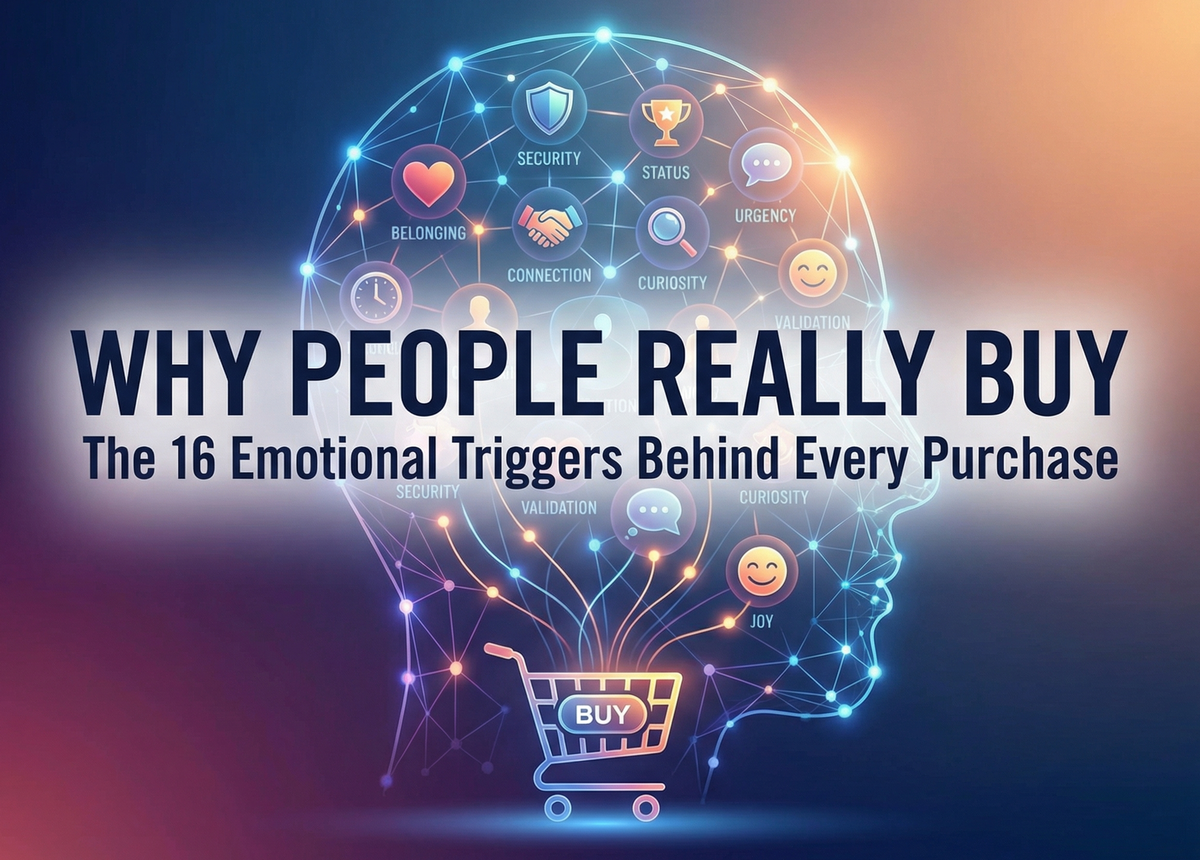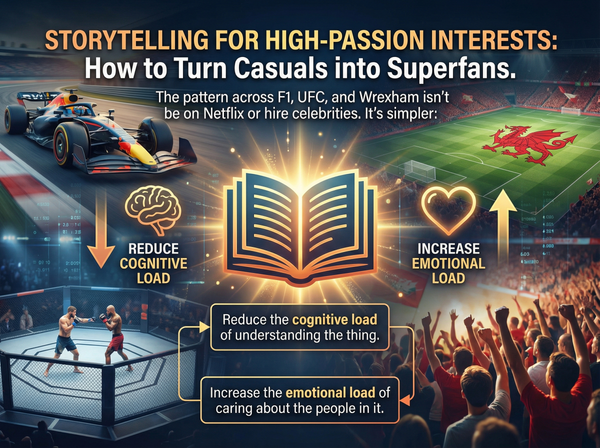Why People Really Buy: The 16 Emotional Triggers Behind Every Purchase

As a marketer, you're not just selling products or services; you're selling solutions to emotional needs. The most compelling campaigns don't just list features; they tap into the core drivers that influence human behavior.
To truly connect with your audience, you need to understand the powerful emotional levers that move them.
Let's explore the 16 dominant emotions and how you can effectively use them to build stronger customer relationships and drive sales.
The Foundation: Emotions that Drive Action
These emotions are deeply ingrained and often serve as the primary motivators for our actions.
- Greed: The desire for more - more money, more possessions, more experiences.
- Why it's Important: This emotion taps into a fundamental human desire for growth and abundance. People are naturally drawn to opportunities that promise a bigger reward for their effort or investment.
- Marketing Application: Highlight exclusive offers, limited-time deals, or the potential for financial gain. Use phrases like Double your results, Earn 20% cashback, or Get more for less. This works particularly well for financial products, loyalty programs, and sales promotions.
- Campaign Example: McDonald’s Supersize Me offers — more food for just a little extra.
- Fear: The anxiety or apprehension about a potential threat or negative outcome.
- Why it's Important: Fear is a powerful motivator because it prompts immediate action to avoid a negative consequence. It triggers a problem-solving mindset.
- Marketing Application: Focus on a problem your product solves and frame it as a looming threat. Cyber-security software sells by highlighting the fear of a data breach. Home security systems play on the fear of a break-in. Health insurance campaigns often use the fear of medical debt. The key is to present your product as the clear, safe solution to that fear.
- Campaign Example: LifeLock ads highlighting identity theft risk.
- Vanity: The excessive pride in one's appearance, abilities, or achievements.
- Why it's Important: This emotion is all about self-image and social validation. People want to feel good about themselves and be perceived in a positive light by others.
- Marketing Application: Showcase how your product enhances a customer's image, social status, or self-esteem. Luxury brands, cosmetics, and fitness products lean heavily on vanity. Use aspirational imagery and testimonials that focus on how the user feels and is perceived after using the product. Unlock your best skin and turn heads.
- Campaign Example: Apple’s iPhone campaigns: sleek design + lifestyle imagery = prestige.
- Love: A strong feeling of affection and care.
- Why it's Important: Love is a universal emotion that drives us to protect and care for those we hold dear. It creates a powerful sense of connection and loyalty.
- Marketing Application: Center your campaign around family, relationships, and community. Think of commercials for jewelry, gifts for special occasions, or brands that support family values. Campaigns that show a product strengthening bonds between people resonate deeply. Show them you care with a gift from the heart.
- Campaign Example: Hallmark’s, When you care enough to send the very best.
- Pride: A feeling of deep satisfaction from one's own achievements or those of a group they belong to.
- Why it's Important: Pride is an empowering emotion that makes people feel a sense of accomplishment and belonging. It reinforces their identity and values.
- Marketing Application: Frame your product as a way for customers to demonstrate their success or support a cause they believe in. Companies that donate to charity or use sustainable practices can tap into the pride a customer feels for supporting a good cause. Wear your success with pride is a common slogan for business-oriented products.
- Campaign Example: TOMS shoes — pride in giving with every purchase.
- Lust: An intense, passionate desire, often for something physical or sensory.
- Why it's Important: Lust triggers a deep, almost primal desire for a product or experience. It creates an irresistible urge that can override rational decision-making.
- Marketing Application: Use evocative language and sensory imagery to create a sense of desire. This is commonly seen in the food and beverage industry, where close-up shots and descriptions like rich, creamy, and decadent are used to make the product irresistible.
- Campaign Example: Godiva’s sensual, slow-motion chocolate pours.
- Revenge: The action of inflicting hurt or harm on someone for an injury or wrong suffered at their hands.
- Why it's Important: While tricky to use ethically, revenge can be a powerful motivator for change. People want to overcome obstacles or get back at a problem that has wronged them.
- Marketing Application: Reframe the enemy. The enemy isn't a person but an inefficiency, a competitor, or a bad experience. For example, a financial app can be marketed as helping you get revenge on your credit card debt by paying it off faster. A productivity tool can help you get revenge on wasted time.
- Campaign Example: Avis’s, We try harder (turning being #2 into a competitive comeback).
The Drivers: Emotions that Influence Identity and Status
These emotions are closely tied to how we see ourselves and how we want to be seen by others.
- Health: The state of being free from illness or injury.
- Why it's Important: Health is a foundational need. Our desire to feel well and live a long, fulfilling life is a constant motivator.
- Marketing Application: Emphasize the long-term benefits of your product for a customer's well-being. This is a staple in the wellness, fitness, and organic food industries. Use phrases like Invest in a healthier you and Nourish your body.
- Campaign Example: Fitbit framing as empowerment over health.
- Security: The state of feeling safe, stable, and free from danger or anxiety.
- Why it's Important: Humans have an innate need for security. We want to know our family, our finances, and our future are protected.
- Marketing Application: Highlight guarantees, warranties, or the protective features of your product. Financial services, insurance companies, and home security brands build their entire value proposition on this emotion. Enjoy peace of mind with our secure platform.
- Campaign Example: ADT home security ads showing intruder prevention.
- Power: The ability or capacity to influence the behavior of others or the course of events.
- Why it's Important: People want to feel in control of their lives and their environment. The desire for power drives innovation and ambition.
- Marketing Application: Position your product as a tool that empowers the user. B2B software, for example, can be marketed as giving a company a powerful advantage over the competition. Fitness trackers can be framed as giving the user power over their health.
- Campaign Example: Salesforce’s No software empowering companies with cloud control.
- Recognition: The acknowledgment of something's existence, validity, or legality.
- Why it's Important: Humans are social creatures. We crave validation and acknowledgment from our peers and communities.
- Marketing Application: Use customer testimonials, awards, and endorsements to build social proof. Loyalty programs and membership tiers can also appeal to the desire for recognition by giving special members a sense of being seen and appreciated. Join thousands of satisfied customers who love our product.
- Campaign Example: Starbucks Rewards tiers giving names like Gold Member.
- Fame: The state or quality of being widely known or recognized.
- Why it's Important: The desire for fame is a heightened version of the need for recognition. It taps into the fantasy of being an idol or a leader.
- Marketing Application: Connect your brand to influencers or celebrities. As seen on TV or Used by your favorite creators are common strategies. This is especially effective in fashion, beauty, and lifestyle markets.
- Campaign Example: Nike campaigns featuring athletes like Michael Jordan & Serena Williams.
- Fortune: A large amount of money or possessions.
- Why it's Important: Fortune is the tangible representation of success and security. The pursuit of wealth is a powerful driver for many people.
- Marketing Application: Focus on the financial prosperity your product can bring. Investment services, real estate, and online courses that promise to teach a profitable skill are all built on this emotion. Unlock your path to financial freedom.
- Campaign example: Robinhood’s Everyone can invest democratizing wealth.
The Core: The Fundamental Human Desires
These emotions are the deepest and most universal drivers of human behavior.
- Survival: The state or fact of continuing to live or exist.
- Why it's Important: This is the most primal emotion. Everything we do is, on some level, a means of self-preservation.
- Marketing Application: Highlight features that ensure safety and continuity. This is a core driver for insurance, security systems, and emergency preparedness products. The message is simple: Without this, you are at risk. Ensure your family's future.
- Campaign Example: Insurance ads showing families protected against accidents.
- Acceptance: The action of consenting to receive or undertake something offered.
- Why it's Important: The need to belong is a fundamental human drive. We want to be part of a group, a community, or a culture.
- Marketing Application: Create a sense of community around your brand. Join the club, or Welcome to the family messaging makes customers feel like they belong to something bigger than themselves. Social media groups and exclusive communities are built on this principle.
- Campaign Example: CrossFit’s community-first brand positioning.
- Happiness: The state of being happy.
- Why it's Important: Ultimately, what everyone wants is to be happy. This is the end goal of every other emotion—fear is about avoiding unhappiness, greed is about seeking the happiness that wealth can bring.
- Marketing Application: Use uplifting imagery, positive language, and aspirational stories that promise joy and satisfaction. Many brands, from soft drinks to theme parks, sell an experience of pure happiness, positioning their product as a catalyst for a joyful moment.
- Campaign Example: Coca-Cola’s Open Happiness.
Why This Matters
By understanding these 16 dominant emotions, you gain a powerful lens through which to view your target audience. You can move beyond shallow product descriptions and create campaigns that resonate on a deep, human level.
The key is to:
- Know your audience: What are their deepest fears, desires, and aspirations?
- Identify the right emotion: Which emotion is the most authentic and powerful fit for your brand and product?
- Be genuine: Don't manipulate, but connect. A campaign built on genuine empathy and understanding will always outperform one built on cheap emotional tricks.
By mastering this emotional spectrum, you can move beyond simply selling and start building genuine, lasting connections that fuel brand loyalty and a passionate customer base.
Keep Crushing!
- Sales Guy


